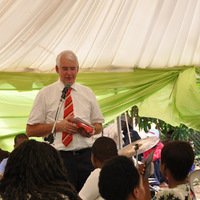Research Interests:
In September 1993, the recently completed 32-bedded Burns Unit in the Queen Elizabeth Central Hospital, Blantyre, Malawi, was officially opened. This represented the culmination of 3 years' planning and construction; this paper... more
In September 1993, the recently completed 32-bedded Burns Unit in the Queen Elizabeth Central Hospital, Blantyre, Malawi, was officially opened. This represented the culmination of 3 years' planning and construction; this paper presents our experience in developing this type of project, and an analysis of the early results of treatment in the unit. The widespread neglect of this common injury in developing countries is highlighted and the importance of input from specialists in this field working in collaboration with local medical and nursing staff is emphasized. The potential for making a significant impact in reducing the morbidity and mortality in burn injuries is highlighted.
Research Interests:
Research Interests:
Research Interests:
Research Interests:
Between 1978 and 1982 14 patients were treated for bile-duct cysts. The predominant clinical signs were obstructive jaundice and hepatomegaly in the younger patients, while pain was the most common symptom in the older patients.... more
Between 1978 and 1982 14 patients were treated for bile-duct cysts. The predominant clinical signs were obstructive jaundice and hepatomegaly in the younger patients, while pain was the most common symptom in the older patients. Ultrasonography was a valuable diagnostic technic but percutaneous transhepatic cholangiography (PTC) and endoscopic retrograde cholangiopancreatography (ERCP) were associated with septic complications; as an alternative, routine preoperative cholangiography is recommended to visualize the type of bile-duct cyst. Excision of the bile-duct cyst was considered the treatment of choice. Excision was performed in 11, and internal drainage in three patients. Cholangitis developed in four children after excision of the cyst. In our series the prognosis was good following surgical treatment, even in younger patients.
Research Interests:
Research Interests:
From 1988 to 1992 160 children with clinically or pathologically proven Burkitt's lymphoma were seen and treated in Queen Elizabeth Central Hospital in Blantyre, Malawi. We present the epidemiologic features, the results of... more
From 1988 to 1992 160 children with clinically or pathologically proven Burkitt's lymphoma were seen and treated in Queen Elizabeth Central Hospital in Blantyre, Malawi. We present the epidemiologic features, the results of staging using ultrasonography, fine needle aspiration biopsy, and the different treatment regimens used. Lack of resources made it extremely difficult to provide the necessary high level of care for these children or to carry out a proper study in the management of this fascinating disease.
Research Interests:
Pretreatment with [131I] metaiodobenzylguanidine (MIBG) followed by surgical resection in advanced neuroblastoma (stage 3 and 4) has been studied in relation to resectability, morbidity and mortality, survival rate after two years,... more
Pretreatment with [131I] metaiodobenzylguanidine (MIBG) followed by surgical resection in advanced neuroblastoma (stage 3 and 4) has been studied in relation to resectability, morbidity and mortality, survival rate after two years, control of distant metastasis and serum levels of LDH as prognostic factors. Twenty-one patients with advanced neuroblastoma were primarily treated with MIBG radiotherapy, followed by surgical resection. Sixteen patients had stage 4 disease. Between 2 and 6 courses of MIBG treatment were given per patient. In 17 patients gross complete resection was achieved. Two patients developed complications directly related to the operation, one died as a result of this. The overall mortality was 38%. MIBG therapy resulted in partial response in 13 patients and in stable disease in 8 patients. Two years survival in the group with partial response was 86% and in the group with stable disease 28%. Because of the resulting excellent general condition of the patients the interval between pretreatment with MIBG and surgery could be very short. Follow-up till December 1994 showed that 13 children were alive for 3 to 47 months. Seven had no evidence of disease. Preoperative MIBG de novo treatment in advanced neuroblastoma is equal to induction chemotherapy, but less toxic.
